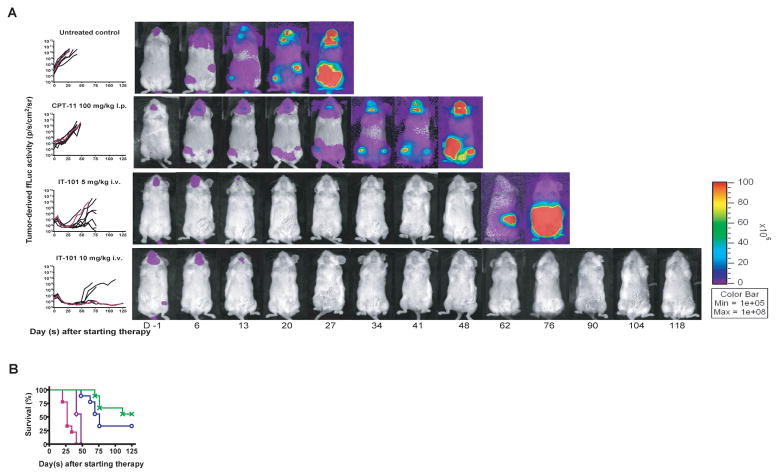Fig. 4.
Administration of IT-101 (5 mg/kg, i.v., qwk × 3) and IT-101 (10 mg/kg, i.v., qwk × 3) in disseminated human B-cell lymphoma xenograft-bearing NOD/scid mice could result in significant better survival as compared to CPT-11. Treatments were initiated on 11 days after tumor inoculation. The treatment arms included untreated control (■), CPT-11 (100 mg/kg, i.p., qwk × 3) (◇), IT-101 (5 mg/kg, i.v., qwk × 3) (○), and IT-101 (10 mg/kg, i.v., qwk × 3) (x). The tumor burden was monitored longitudinally by quantification of tumor-derived ffLuc-activity. (A) Total photon flux normalized for exposure time and surface area and expressed in units of photons/second/cm2/steradian (p/s/cm2/sr) for individual mice was graphed over time and serial pseudocolor images representing light intensity from Daudi+ ffLuc in selected mice were shown. (B) Kaplan-Meier survival curves were plot for each treatment group. The log-rank test was used to compare the percent animal survival between treatment groups. A significant difference between the groups treated with either IT-101 (5 mg/kg, i.v., qwk × 3) or IT-101 (10 mg/kg, i.v., qwk × 3) was not observed; but these two treatment groups could significantly establish better survival as compared to the animals treated with CPT-11 (P = 0.0002 and P < 0.0001, respectively). Points indicate mean survival.

